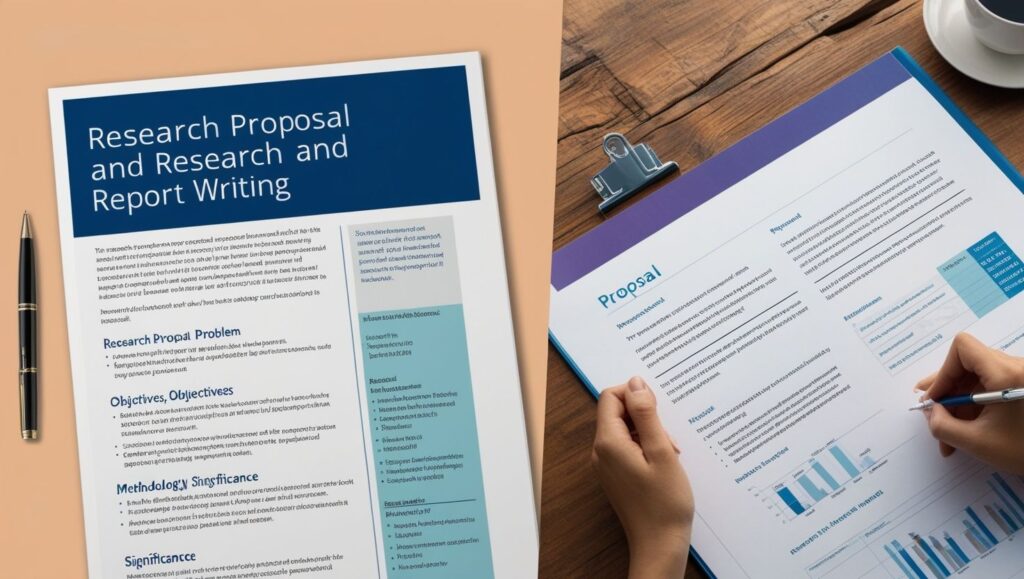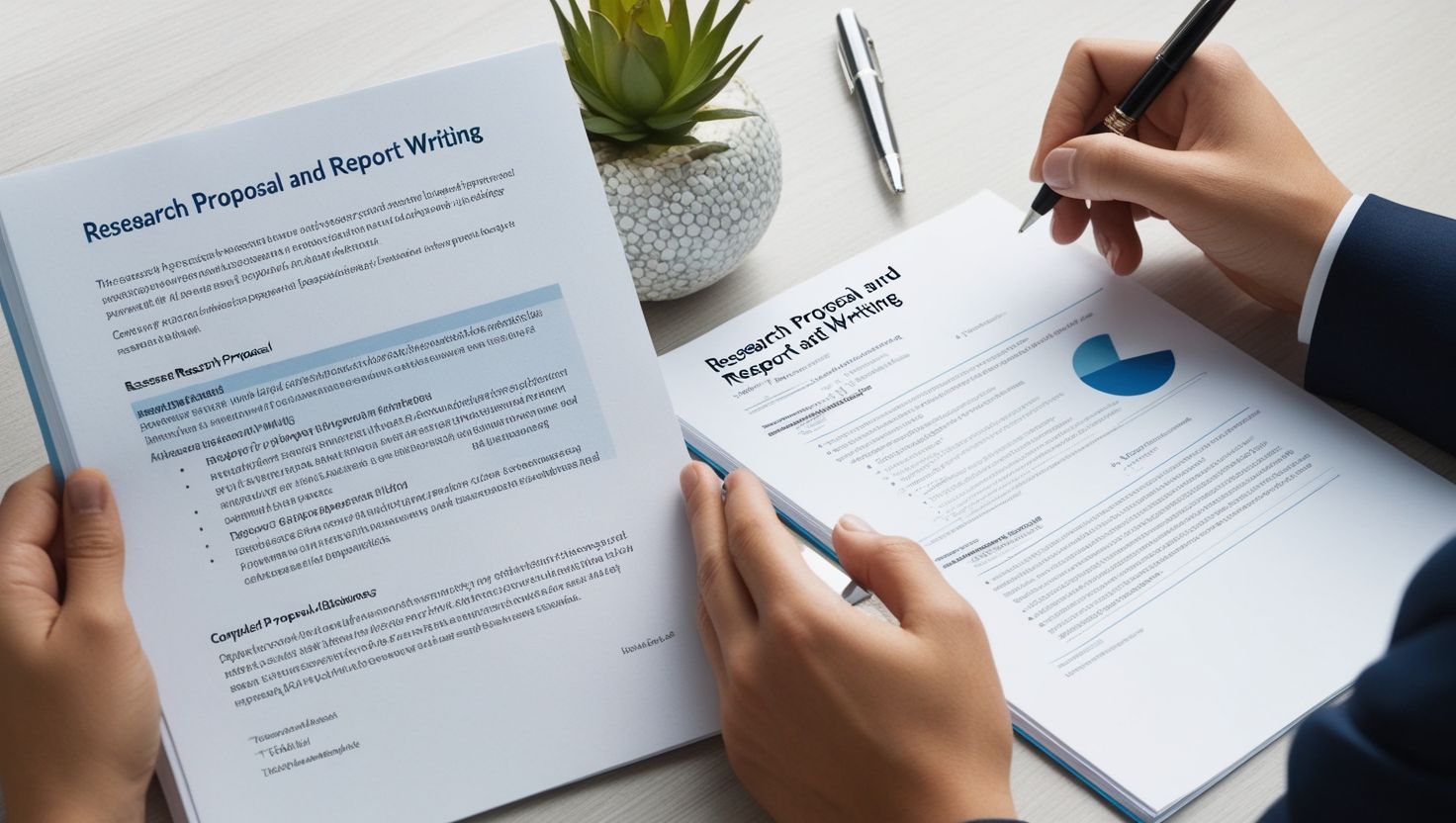Introduction
Research proposal and report writing are crucial components of academic and professional research. A research proposal outlines the plan for a research project, highlighting its objectives, methods, and potential significance. On the other hand, a research report presents the findings of completed research, interpreting and discussing them within the context of the study. Mastery of these processes is vital for researchers to communicate their work effectively and gain funding or support for their projects.
Importance of Research Proposals
A research proposal serves multiple purposes:
- Blueprint for Research: It defines the scope and direction of the study.
- Communication Tool: It helps communicate the research plan to stakeholders, such as funding agencies or academic supervisors.
- Approval Document: It is often a prerequisite for securing permission to proceed with research.
- Feasibility Assessment: It evaluates whether the research can be conducted with the available resources and time.
Key Components of a Research Proposal
- Title: The title should be concise, informative, and reflective of the research scope.
- Abstract: A brief summary outlining the problem, objectives, methodology, and expected outcomes.
- Introduction: It provides background information, identifies the research problem, and states the study’s significance.
- Objectives: These are specific, measurable, achievable, relevant, and time-bound (SMART) goals of the research.
- Literature Review: A review of existing studies that highlights gaps the proposed research aims to address.
- Methodology:
- Design: Explains the research approach (qualitative, quantitative, or mixed-methods).
- Data Collection: Describes tools, instruments, and processes for data collection.
- Analysis: Details the methods for analyzing collected data.
- Timeline: A clear schedule indicating when each phase of the research will be conducted.
- Budget: Estimates of costs associated with the research.
- References: Citations of all sources referenced in the proposal.
Tips for Writing a Research Proposal
- Clarity: Avoid jargon and ensure the proposal is easy to understand.
- Precision: Be specific about objectives, methods, and expected outcomes.
- Relevance: Ensure the proposal addresses a significant research problem.
- Feasibility: Propose realistic methods and timelines.

Research Report Writing
A research report is a comprehensive document that presents the entire research process and its findings. It is critical for disseminating knowledge and contributing to the broader academic or professional field.
Importance of Research Reports
- Documentation: Records the research process for future reference.
- Knowledge Sharing: Disseminates findings to stakeholders and the wider community.
- Evaluation: Allows others to assess the validity and reliability of the study.
- Informs Practice: Provides data that can inform policy, practice, or further research.
Structure of a Research Report
- Title Page:
- Title of the research.
- Author(s) name(s).
- Institution or organization affiliation.
- Date of submission.
- Abstract:
- A concise summary of the research, including objectives, methods, results, and conclusions.
- Introduction:
- Overview of the research problem.
- Objectives and research questions.
- Importance of the study.
- Literature Review:
- Summary of existing research.
- Identification of gaps addressed by the study.
- Methodology:
- Research design and approach.
- Data collection methods.
- Sample population and sampling techniques.
- Tools and instruments used.
- Results:
- Presentation of data, often using tables, graphs, or charts.
- Descriptive and inferential statistics.
- Discussion:
- Interpretation of results.
- Comparison with previous studies.
- Implications of findings.
- Conclusion and Recommendations:
- Summary of key findings.
- Practical applications and suggestions for future research.
- References:
- Comprehensive list of all sources cited in the report.
- Appendices:
- Additional materials such as questionnaires, raw data, or detailed calculations.
Effective Writing Techniques
- Coherence: Maintain a logical flow between sections.
- Consistency: Use consistent terminology and formatting.
- Conciseness: Avoid unnecessary details while covering essential points.
- Accuracy: Ensure data and interpretations are accurate and unbiased.
Common Challenges in Proposal and Report Writing
- Ambiguity: Lack of clarity in objectives or methods.
- Time Management: Inadequate planning leading to rushed or incomplete documents.
- Inadequate Literature Review: Overlooking critical studies or failing to identify research gaps.
- Weak Data Presentation: Poorly formatted tables or unclear charts.
- Plagiarism: Failure to properly credit sources, leading to ethical and legal issues.
Overcoming Challenges
- Plan Thoroughly: Develop a detailed outline before writing.
- Seek Feedback: Review drafts with peers or mentors.
- Use Software: Leverage tools for data visualization and plagiarism checking.
- Stay Informed: Continuously update knowledge on best practices in research writing.
Ethical Considerations
- Honesty: Ensure accuracy in data collection, analysis, and reporting.
- Transparency: Clearly explain methods and acknowledge limitations.
- Plagiarism Prevention: Cite all sources and avoid copying content.
- Confidentiality: Protect the privacy of participants and sensitive data.
Conclusion
Research proposal and report writing are foundational to effective research communication. A well-crafted proposal secures support for a project, while a detailed report shares valuable findings with the world. By adhering to structured formats, maintaining ethical standards, and addressing potential challenges, researchers can produce compelling and impactful documents that advance knowledge and inspire innovation.

6 thoughts on “Research Proposal and Report Writing”
Comments are closed.